

KDL Eurydice Brief finals. KDL 2017 internet. Publication. CLIL Magazine Spring 2016 by Patrick de Boer. Volume 2016 – Issue 4. Latin American Journal of Content & Language Integrated Learning. Coonan, C.
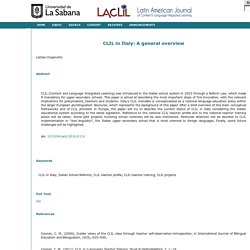
M., (2008), Insider views of the CLIL class through teacher self-observation-introspection, in International Journal of Bilingual Education and Bilingualism, 10(5), 625–646. Coonan, C. M., (2011), CLIL in (Language) Teacher Training, Studi di Glottodidattica, 2, 1–14. Coonan, C. M., (2012), The foreign language curriculum and CLIL, in Synergies Italie, 8, 117–128. Coyle, D., Hood, P., Marsh, D. (2010), CLIL: Content and Language Integrated Learning, Cambridge, England, Cambridge University Press. European Commission, (2012), Rethinking Education: Investing in skills for better socio-economic outcomes. Webinar with India 17 Jan. 2 pm Online Class by Unitus.
Webinar with Phil Ball 16 Jan. 3 pm CET Online Class by Unitus. CLIL LESSON PLANS - Teacher's Zone. Resource Centre - Useful Material. Università di Foggia. Download free sample material from onestopclil. Try before you buy with these free CLIL resources.
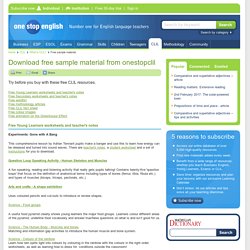
Free Young Learners worksheets and teacher's notesFree Secondary worksheets and teacher's notesFree wordlistFree methodology articlesFree CLIL fact sheetFree colour imagesFree animation on the Greenhouse Effect Free Young Learners worksheets and teacher's notes Experiments: Gone with A Bang This comprehensive lesson by Adrian Tennant pupils make a banger and use this to learn how energy can be released and turned into sound waves. There are teacher's notes, a student worksheet and a set of instructions for you to download.
CLIL worksheets. TED: Ideas worth spreading. Free Online Technology ICT Lessons. Clilstore - Teaching units for content and language integrated learning. Teaching unitsfor Content and Language Integrated Learning HelpAbout Select the language you are learning and your level to see the available units.

Level AnyBasicA1A2B1B2C1C2Advanced This project has been funded with support from the European Commission. Disclaimer: This publication reflects the views only of the author, and the Commission cannot be held responsible for any use which may be made of the information contained therein. The practice and theory of CLIL. Khan Academy. InstaGrok.com. A Quick Guide to the Flipped Classroom. Extensive reading. The reading skill is most often taught by close study of short passages followed by analysis of language.

Extensive reading: An alternative approach Aims of extensive reading The characteristics of an extensive reading approach Motivation The teacher's role Conclusion The value of this intensive reading procedure, with its focus on the teaching of discrete reading skills has been questioned by some, who claim that teaching students reading strategies does not necessarily make them better readers. It is widely believed that people become good readers through reading, and that learning how to read should mean a focus of attention on the meaning rather than the language of the text. Quaderno n. 14. English Readers. 19 January 2017 By Nastya315120StudentGood morning and I love my life so far away and I love my love love my best friends love my life and my love for 18 January 2017 By KrmlindaStudentJusto good friends is The last book I've read and I need The free resources 17 January 2017.

Pearson English Readers. Macmillan Readers – English Reading Resources. Welcome to Penguin Readers. Oxford University Press. Free Visual Dictionary & Thesaurus. 10 Ways to Use Technology to Build Vocabulary. Click the "References" link above to hide these references.

Adesope, O.O., Lavin, T., Thompson, T., & Ungerleider, C. (2010). A systematic review and meta-analysis of the cognitive correlates of bilingualism. Review of Educational Research, 80(2), 207-245. doi:10.3102/0034654310368803 Baumann, J.F., & Kame'enui, E.J. Educational Technology and Mobile Learning: 5 Great Tools to Improve Students Reading Comprehension Skills. September 27, 2014 One of the key concerns I often hear primary teachers vociferate revolves around the potential of technology in enhancing students reading comprehension skills.
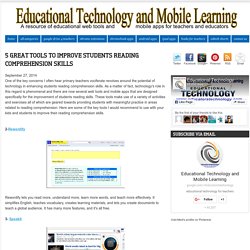
As a matter of fact, technology's role in this regard is phenomenal and there are now several web tools and mobile apps that are designed specifically for the improvement of students reading skills. 5 Tech Tools to Aid Your Reading Comprehension. Words are like teenagers.

They are manageable individually, but once they start hanging out with each other, it can be difficult to figure out how they work as a whole. Any parent or teacher who has taught a child to read will tell you that interpreting a text involves two steps. The first step involves decoding and defining individual words. Telescopic Text. Creating social phrasebooks with Phraseum. I spend a lot of time looking at different web-based tools and apps and thinking about if and how they can be used for learning.
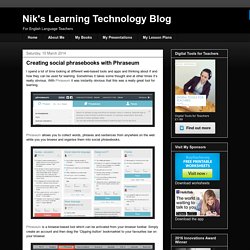
Sometimes it takes some thought and at other times it’s really obvious. With Phraseum it was instantly obvious that this was a really great tool for learning. Phraseum allows you to collect words, phrases and sentences from anywhere on the web while you you browse and organise them into social phrasebooks. Phraseum is a browser-based tool which can be activated from your browser toolbar.
Simply create an account and then drag the ‘Clipping button’ bookmarklet to your favourites bar on your browser. Once that’s done you can just collect any words or phrases that you find online by highlighting them and then clicking on the bookmarklet. Extensive reading: why it is good for our students… and for us. What is Extensive Reading (ER)?
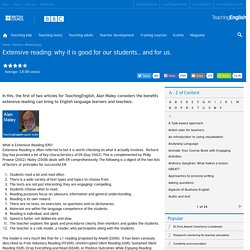
Extensive Reading is often referred to but it is worth checking on what it actually involves. Richard Day has provided a list of key characteristics of ER (Day 2002). This is complemented by Philip Prowse (2002). Maley (2008) deals with ER comprehensively. The following is a digest of the two lists of factors or principles for successful ER: Reading for Pleasure. Stephen Krashen explains why we should stop scolding teenagers and their schools Contrary to popular opinion, there is no evidence that teenagers are less engaged in literacy activities today than teenagers of the past.
Teenagers today do just as much book reading as teenagers did 65 years ago, and it appears that they are more involved in reading and writing in general when we include computer use in the analysis. Reading matters: Extensive reading. Bell - Extensive Reading: Why? and How? The Internet TESL Journal Timothy Bell timothy [at] hsc.kuniv.edu.kwKuwait University Abstract An extensive reading program was established for elementary level language learners at the British Council Language Center in Sanaa, Yemen.
Research evidence for the use of such programs in EFL/ESL contexts is presented, emphasizing the benefits of this type of input for students' English language learning and skills development. Seven Benefits of Extensive Reading for English Language Students - Kieran Donaghy. What is extensive Reading? In simple terms Extensive Reading is reading as many easy books as possible for pleasure, and can be contrasted with intensive reading which is slow, careful reading of a short, difficult text. What’s the point of Extensive Reading?
To celebrate the launch of Project fourth edition, Domino author, Nina Prentice explores the relevance of extensive reading in the upper primary classroom. School is generally about hierarchies and rules. The teacher is the authority on and dispenser of the syllabus. Students are novices. Their purpose is to consume and learn the year’s programme of study and satisfy the requirements of the examination system. But, if we believe that learning is not just about passing exams, our classrooms need not follow this pattern. Why is extensive reading important? - Fremmedspråksenteret - Høgskolen i Østfold. Extensive reading. Moodle for Teachers (M4T): Log in to the site. Quaderno n. 14. CLIL Art: Dali. Submitted 8 years 9 months ago by Chris Baldwin. This activity is a 'Picasso dictation' where the teacher describes a picture and the students draw it.
This is based on Salvador Dali’s 1937 surrealist painting “Swans Reflecting Elephants”. Give CLIL time. Article: Skills for CLIL. In this article John Clegg outlines the language and learning skills which a learner learning a subject through the medium of English as a second language (L2) requires. 1. Introduction What I want to do in this article is outline the language and learning skills which a learner learning a subject through the medium of English as a second language (L2) will need. Robert Quinn - ELT & CLIL Links. Putting CLIL into Practice - factworld.info. Article: Planning CLIL lessons.
By John Clegg. CLIL links - A trip to CLIL. Web2 - 4 Languages Teachers - Web2.0 tools. INTEGRATING MOBILE DEVICES INTO LANGUAGE LEARNING TO MEET THE 21ST CENTURY EDUCATIONAL CHALLENGES. Home » novembre. CLIL IN ACTION – TEAM TEACHING. What is Web 2.0. Web 2.0 is the current state of online technology as it compares to the early days of the Web, characterized by greater user interactivity and collaboration, more pervasive network connectivity and enhanced communication channels.
One of the most significant differences between Web 2.0 and the traditional World Wide Web (WWW, retroactively referred to as Web 1.0) is greater collaboration among Internet users, content providers and enterprises. Originally, data was posted on Web sites, and users simply viewed or downloaded the content. Increasingly, users have more input into the nature and scope of Web content and in some cases exert real-time control over it.
The social nature of Web 2.0 is another major difference between it and the original, static Web. Increasingly, websites enable community-based input, interaction, content-sharing and collaboration. Article: Teacher collaboration in CLIL. By John Clegg. CLIL and CALL for a teacher’s expertise: an international training experience. Abstract. Moodle for Teachers (M4T): Log in to the site. e484 emi cover option 3 final web. 143EN. Moodle for Teachers (M4T): Log in to the site. BloomDigital. Explaining BICS and CALP. Thinking skills for CLIL. CLIL: A lesson framework. Content and Language Integrated Learning. What is CLIL?